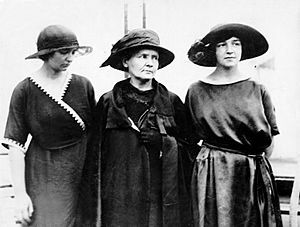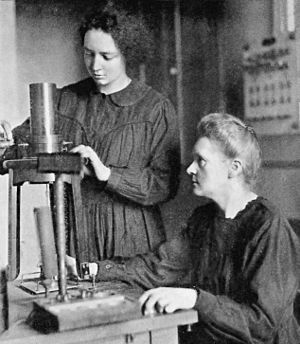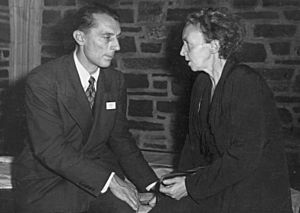Irène Joliot-Curie facts for kids
Quick facts for kids
Irène Joliot-Curie
|
|
|---|---|

Curie c. 1920s
|
|
| Born |
Irène Curie
12 September 1897 Paris, France
|
| Died | 17 March 1956 (aged 58) Paris, France
|
| Alma mater | University of Paris |
| Spouse(s) | |
| Children | |
| Awards | Nobel Prize for Chemistry (1935; jointly) |
| Scientific career | |
| Fields | |
| Institutions | |
| Thesis | Recherches sur les rayons α du polonium : oscillation de parcours, vitesse d'émission, pouvoir ionisant (1925) |
| Doctoral advisor | Paul Langevin |
| Doctoral students | Her children |
| Signature | |
Irène Joliot-Curie (born Curie; 12 September 1897 – 17 March 1956) was a French chemist and physicist. She was the older daughter of famous scientists Pierre Curie and Marie Skłodowska–Curie. Irène was also the wife of Frédéric Joliot-Curie.
In 1935, Irène and her husband, Frédéric, won the Nobel Prize in Chemistry. They received it for discovering something called induced radioactivity. This made them the second married couple ever to win a Nobel Prize. Her parents, Marie and Pierre Curie, were the first. The Curie family has won five Nobel Prizes in total, which is more than any other family.
Irène Joliot-Curie was also one of the first three women to join the French government. In 1936, she became an undersecretary for Scientific Research. After World War II, in 1945, she helped create the new French Atomic Energy Commission (CEA). She died in Paris in 1956 from a type of blood cancer called acute leukemia. This was likely caused by her exposure to radioactive materials like polonium and X-rays during her work.
Contents
Biography
Early Life and Education
Irène was born in Paris, France, on September 12, 1897. She was one of Marie and Pierre Curie's two daughters. Her younger sister was named Ève. Sadly, their father, Pierre, died in 1906 in an accident. Marie then raised Irène and Ève on her own.
Education was very important to the Curie family. Irène first went to a school near the Paris Observatory. This school had a more challenging program than other schools. By 1906, it was clear Irène was very good at mathematics. Her mother decided to focus on her special talents instead of sending her to a regular public school.
Marie Curie teamed up with other French scholars, like Paul Langevin. They formed a group called "The Cooperative." This was a private school for nine students, who were children of important academics in France. Each scholar taught the children in their own homes. The lessons were very diverse. They included science, research, and even subjects like Chinese. Irène studied in this unique environment for about two years.
When Irène was thirteen, she and her sister Ève went to Poland for the summer. They stayed with their aunt Bronia, who was Marie's sister. Even on holiday, Irène's education was strict. She had German and trigonometry lessons every day. In 1914, Irène returned to a more traditional school, the Collège Sévigné. She then went to the Sorbonne to get her first university degree. However, her studies were interrupted in 1916 by World War I.
Helping During World War I

During college, Irène took a nursing course. She wanted to help her mother, Marie Curie, who was working as a nurse radiographer on the battlefield. Irène started by assisting her mother. She learned to use X-ray equipment to help soldiers. She taught doctors how to find pieces of shrapnel (metal fragments from bombs) inside bodies using X-rays. She also learned how to fix the X-ray machines herself.
Irène worked in many different hospitals and battle zones. These included places like Furnes, Ypres, and Amiens. She received a military medal for her important help in X-ray facilities in France and Belgium.
After the war, Irène went back to the Sorbonne in Paris. In 1918, she finished her second university degree in mathematics and physics. Then, she became her mother's assistant at the Radium Institute. This institute was built by her parents. For her PhD, Irène studied the alpha decay of polonium. Polonium was an element discovered by her parents and named after Marie's home country, Poland. In 1929, Irène became a Nurse of Science.
Groundbreaking Research

In 1924, as Irène was finishing her PhD, she was asked to teach a young chemical engineer named Frédéric Joliot. She taught him the special lab skills needed for working with radioactive materials. Later, Irène and Frédéric got married.
From 1928, Irène and Frédéric combined their research efforts. They focused on studying atomic nuclei, which are the centers of atoms. In 1932, they had full access to Marie Curie's polonium. They used it in experiments with gamma rays to try and find a particle called the positron.
Their experiments actually detected both the positron and the neutron. However, they didn't fully understand what these discoveries meant at the time. Other scientists, Carl David Anderson and James Chadwick, later got credit for discovering these particles. These discoveries were very important. Along with the electron (discovered in 1897), they showed that atoms were not just solid balls, as once thought.
In 1933, Irène and Frédéric were the first to correctly calculate the mass of the neutron. They kept working to make their mark in the science world. They developed a new idea from an interesting experiment. They shot alpha rays at aluminum. They noticed that only protons were detected. They suggested that protons changed into neutrons and positrons.
They presented this new idea at the Seventh Solvay Conference in October 1933. This conference brought together many famous physicists and chemists. Irène and Frédéric shared their theory and results. Most of the 46 scientists there were critical of their findings. But the Joliot-Curies were able to build on this idea later.
In 1934, the Joliot-Curies made a discovery that secured their place in science history. Marie and Pierre Curie had found naturally occurring radioactive elements. Building on this, Irène and Frédéric achieved something like an alchemist's dream: they turned one element into another! They created radioactive nitrogen from boron. They also made radioactive versions of phosphorus from aluminum, and silicon from magnesium.
For example, they shot alpha particles (which are helium nuclei) at a stable type of aluminum. This created an unstable type of phosphorus: 27Al + 4He → 30P + 1n. This process is called positron emission or beta decay. It happens when a proton in a radioactive nucleus changes into a neutron, releasing a positron and an electron neutrino.
At that time, radioactive materials were becoming important in medicine. This discovery meant that radioactive materials could be made quickly, cheaply, and in large amounts. The Nobel Prize for Chemistry in 1935 brought them fame and recognition. Irène was also given a professorship at the Faculty of Science.
Irène's research group also did important work on radium nuclei. This work helped a German team, led by Otto Hahn, Lise Meitner, and Fritz Strassman, discover nuclear fission. Nuclear fission is the splitting of an atom's nucleus, which releases huge amounts of energy. Lise Meitner's calculations actually showed that Irène's earlier results could be explained by nuclear fission.
In 1948, using their knowledge of nuclear fission, the Joliot-Curies and other scientists created France's first nuclear reactor. Irène was a commissioner of the Atomic Energy Commission (CEA), and Frédéric was its director. The reactor, named Zoé, used nuclear fission to produce five kilowatts of power. This was the start of nuclear energy as a power source for France. Thanks to their work, France now gets about 75% of its electricity from nuclear energy. France even sells extra energy to other European countries.
Years of working closely with radioactive materials eventually affected Irène's health. In 1946, a sealed capsule of polonium accidentally exploded on her lab bench. She was diagnosed with leukemia, a type of blood cancer. She had treatments and operations, but her health kept getting worse. Despite this, Irène continued to work. In 1955, she planned new physics laboratories for the Orsay Faculty of Sciences, which is now part of the Paris-Saclay University.
Political Involvement
The Joliot-Curies became very aware of the rise of fascism, a political movement that was against freedom. They opposed these ideas. In 1934, they joined the Socialist Party. A year later, they joined a group called the Comité de vigilance des intellectuels antifascistes. In 1936, they actively supported the Republican side in the Spanish Civil War. That same year, Irène was made Undersecretary of State for Scientific Research by the French government. In this role, she helped create the Centre National de la Recherche Scientifique, a major research organization.
Frédéric and Irène visited Moscow for a special anniversary of the Russian Academy of Science. They returned feeling supportive of their Russian colleagues. Frédéric's close ties to the French Communist Party later caused Irène to be held at Ellis Island during a trip to the US. She was going there to speak in support of Spanish refugees.
The Joliot-Curies had always shared all their scientific work openly. This was a tradition started by Pierre and Marie. But they became worried about the danger if their nuclear fission research was used for military purposes. So, on October 30, 1939, they put all their documents on nuclear fission into the vaults of the French Academy of Sciences. They stayed there until 1949.
Irène's political career continued after World War II. She became a commissioner in the Commissariat à l'énergie atomique. She also found time for scientific work. In 1946, she became the director of her mother's Institut Curie.
Irène Joliot-Curie was very active in promoting education for women. She served on the National Committee of the Union of French Women. She was also part of the World Peace Council, working for peace around the globe. Both Irène and Frédéric were given memberships to the French Légion d'honneur. Irène was an officer, and Frédéric was a commander, for his work in the resistance during the war.
Personal Life
After they married in 1926, Irène and Frédéric combined their last names to Joliot-Curie. They had two children. Their daughter, Hélène, was born eleven months after they married. Their son, Pierre, was born in 1932.
During World War II, between 1941 and 1943, Irène got tuberculosis. She had to spend time recovering in Switzerland. She was worried about her own health. It was also very hard for her knowing her husband was fighting in the resistance against German troops. Her children were also in German-occupied France. She made several risky trips back to France. German troops even detained her at the Swiss border more than once.
Finally, in 1944, Irène decided it was too dangerous for her family to stay in France. She took her children back to Switzerland. In September 1944, after months of not hearing from Frédéric, Irène and her children were finally able to reunite with him.
Irène was a strong supporter of her beliefs. She was a passionate member of the feminist movement, especially for women in science. She also worked for peace. She repeatedly applied to the French Academy of Sciences, a top scientific group. She knew they would reject her because they didn't accept women. She did this to highlight that they excluded women.
Irène also spoke at many events, like the International Women's Day conference. She played a big role for the French group at the World Congress of Intellectuals for Peace. This event promoted the World Peace movement. In 1948, during a coal miners' strike, Irène reached out to Paris Newsletters. She convinced families to temporarily adopt the children of the striking miners. The Joliot-Curies themselves adopted two girls during that time.
Death
In 1956, after a final period of rest in the French Alps, Irène Joliot-Curie was admitted to the Curie Hospital in Paris. She died on March 17 at age 58 from leukemia. This was likely caused by radiation from polonium-210 she was exposed to during her work. Frédéric's health also declined, and he died in 1958 from liver disease. This was also believed to be from too much radiation exposure.
Irène Joliot-Curie was an atheist and against war. When the French government held a national funeral for her, Irène's family asked for the religious and military parts of the ceremony to be left out. Frédéric was also given a national funeral by the French government.
Irène Joliot-Curie's daughter, Hélène Langevin-Joliot, became a nuclear physicist and professor at the University of Paris. Her son, Pierre Joliot, became a biochemist at the Centre National de la Recherche Scientifique.
Notable Honours
- Nobel Prize in Chemistry in 1935 for the discovery of artificial radioactivity with Frédéric Joliot-Curie.
- Barnard Gold Medal for Meritorious Service to Science in 1940 with Frédéric Joliot-Curie.
- Officer of the Legion of Honor.
Her name was added to the Monument to the X-ray and Radium Martyrs of All Nations in Hamburg, Germany.
See also
 In Spanish: Irène Joliot-Curie para niños
In Spanish: Irène Joliot-Curie para niños
- List of female Nobel laureates
- Women in chemistry
- Stefania Maracineanu
- Timeline of women in science
- Radioactive (film)


